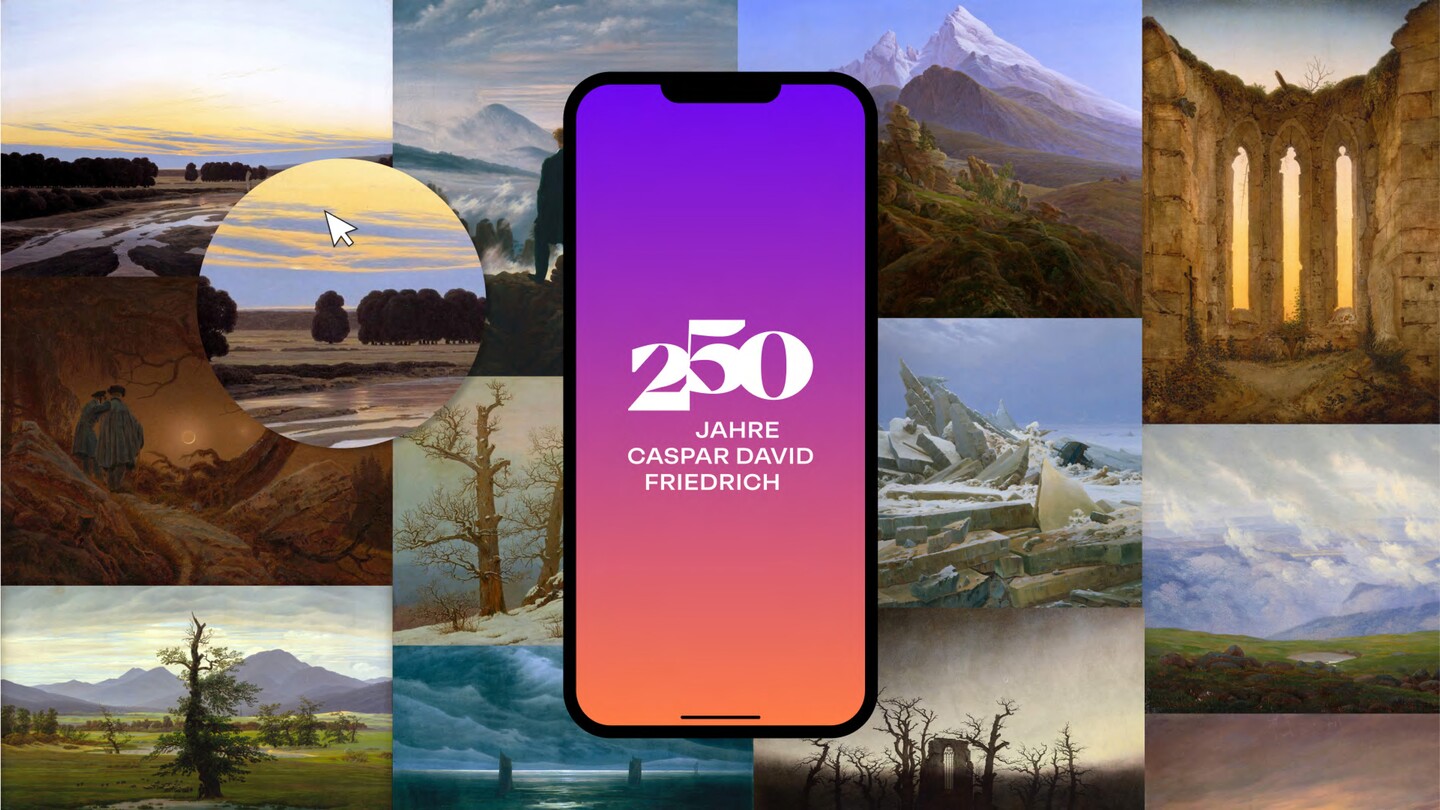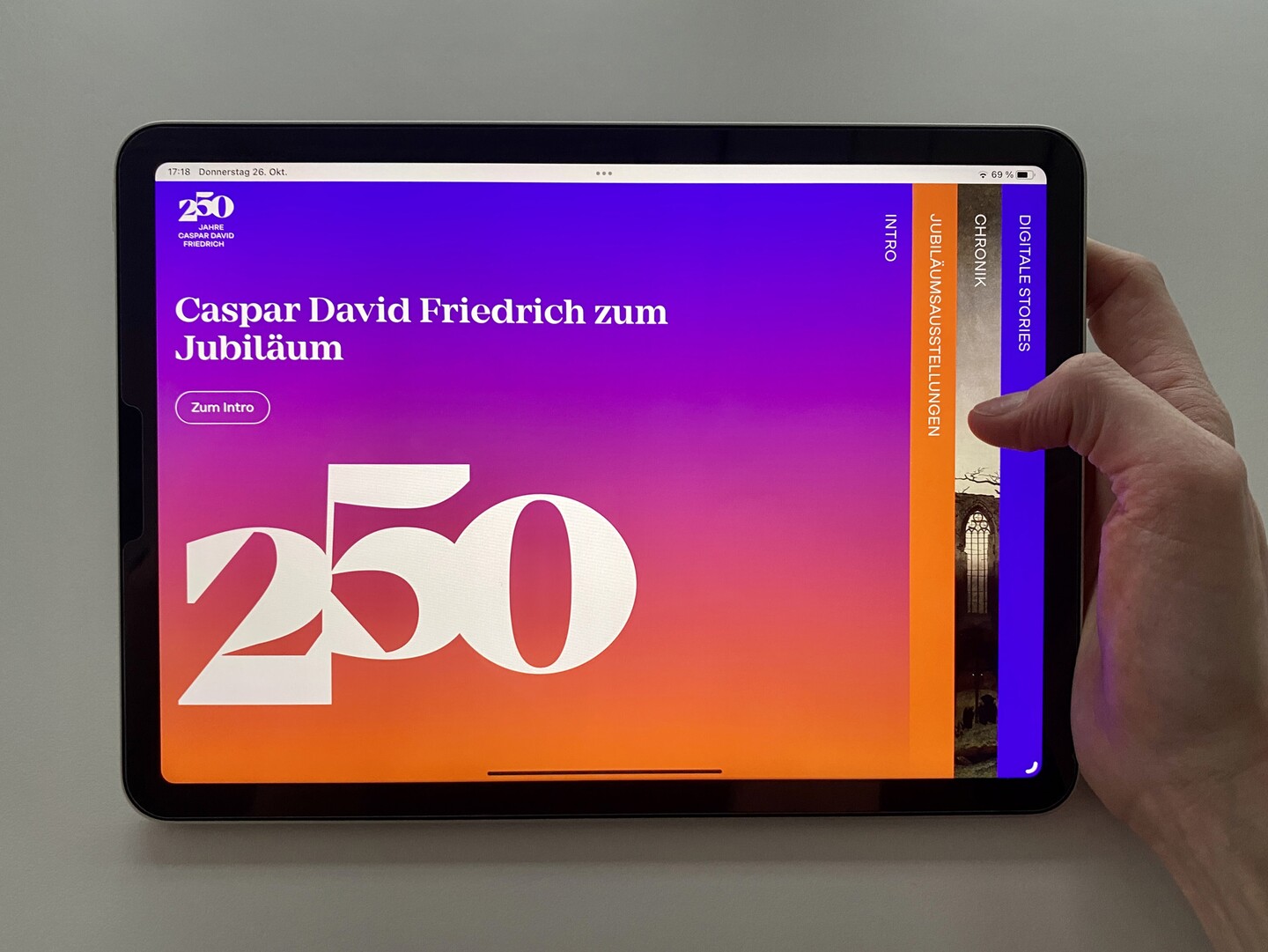New: Caspar David Friedrich Web Portal
PROJECT TEAM HAMBURGER KUNSTHALLE
Christian Auffarth, Petra Bassen, Clara Blomeyer und Dr. Katharina Hoins
CONCEPT/DESIGN AND CODING
Heine Lenz Zizka
A COOPERATION BETWEEN MUSEUMS IN HAMBURG, BERLIN AND DRESDEN AS PART OF THE DIGITAL PROJECT »Datenraum Kultur (Culture Data Space)«
Around 250 works by Caspar David Friedrich (1774-1840) are now accessible via the web portal www.cdfriedrich.de on the most famous painter of German Romanticism. The digital service brings together the artist's most important paintings and drawings from the collections of the Hamburger Kunsthalle, the Staatliche Museen zu Berlin and the Staatliche Kunstsammlungen Dresden. Because some paintings are too fragile to be transported and the drawings are too sensitive to light to be exhibited for any length of time, only the digital allows this overall experience. To get closer to Friedrich's art, the portal offers various formats: The Chronicle provides a broad overview, Shortcuts succinctly explore Friedrich's themes from today's perspective, and the Digital Stories allow users to delve deeply into individual works via topical questions. This unique cooperation between the museums is part of the digital project »Culture Data Space« as one of several lighthouse projects of the Federal Government's digital strategy. The occasion is the 250th anniversary of Caspar David Friedrich's birth in 2024 and the three associated anniversary exhibitions in Hamburg, Berlin and Dresden, which will be complemented by »cdfriedrich.de«. The web portal will be continuously developed beyond the anniversary year 2024.
- More
Arranged chronologically, the chronicle as the heart of the web portal provides a comprehensive impression of Friedrich's work - and at the same time invites you to discover his time individually: important events in the artist's biography and information on current events can be freely shown and hidden, and you can hear from Quotations from Friedrich spoken to the actor Hanns Zischler. More than 500 events, works and statements are continually rearranged through the selection in front of the viewer's eyes - from the highlight view to the complex expert mode. Detailed texts on more than 70 works provide the opportunity to learn more about individual works of art. The result is a comprehensive panorama of his work, enriched by different perspectives on his art from experts in various disciplines.
The web portal provides an introduction to Friedrich's world of images with Shortcuts on topics such as Who am I?, Feeling what is beautiful! or Best Friends Forever, which open up Friedrich's world and work with a wink. Friedrich's works are well-known and popular and yet not feel-good art. Fantasy and severity, sadness and hope, subjectivity and universality, precision and openness are united in them. They do not provide answers, rather they open up space for questions and enable us to draw on ideas from today's world of life. The Digital Stories format therefore goes one step further: it is dedicated to one iconic painting and uses this to develop historical and current questions and theses.
The Digital Stories, on the other hand, allow immersion in the details and backgrounds of selected works: each Digital Story is dedicated to one painting and raises historical and contemporary questions and theories directly addressed to the user.
In the anniversary year of 2024, the chronicle, which focuses on Friedrich's life from 1774 to 1840, will be expanded to include the reception of his art in the decades and centuries after his death. In the course of the preparations for the three exhibitions, further content from the cooperation partners in Hamburg, Berlin and Dresden will be added, for example texts or audio files on Friedrich's main works, further digital stories, and in the future additional multimedia content, from gigapixel recordings to art technology Visualization.
New Features
»Culture Data Space« (Datenraum Kultur)
The web portal for the 250th anniversary of Caspar David Friedrich’s birth was developed as a ‘use case’ for Smart Museum Services within the project »Culture Data Space«. »Culture Data Space« is a joint venture of acatech/Deutsche Akademie der Technikwissenschaften, Behörde für Kultur und Medien der Freien and Hansestadt Hamburg, the Fraunhofer-Institut für Angewandte Informationstechnik FIT, and other application-specific partners.
»Cultural Data Space« is one of 18 lighthouse projects of the German government’s national Digital Strategy. It is fully funded by the Federal Government Commissioner for Culture and the Media. Its purpose is to facilitate the digital networking of cultural institutions and the effortless exchange of culture-related data. The aim is to establish an independent platform for digital products and digital resources for the cultural sphere. Datenraum Kultur is characterized by the simplification of access to and use of data. Its guiding principle is to preserve the sovereignty of data owners, content creators, and service providers in the cultural, media, and creative industries.
In the future, the »Culture Data Space« should make it easier to create offerings comparable to the web portal on Caspar David Friedrich. In the course of the work on the web portal, important requirements and initial prototypes were and are being identified and described, which serve as a basis for developing processes and standards for the »Culture Data Space« .
The Artist
Caspar David Friedrich was born in Greifswald on September 5, 1774 and later studied at the Royal Danish Academy of Fine Arts in Copenhagen before settling in Dresden. He challenged academic tradition by seeking his own sources of inspiration, which he found in nature, often on walks in the scenic countryside around Dresden. And it was in Dresden that Friedrich started a family. He enjoyed a period of great success and then saw his art fall out of favor. More than half a century after his death in 1840, he was rediscovered at the 1906 German Centenary Art Exhibition in Berlin and was celebrated as a pioneer of modern art. His popularity continues to this day, perhaps because there is something profoundly moving in his art about humankind’s relationship to the natural world and the concept of nature.
In cooperation with: Nationalgalerie der Staatlichen Museen zu Berlin, Staatliche Kunstsammlungen Dresden and acatech – Deutsche Akademie der Technikwissenschaften and Fraunhofer-Institut für Angewandte Informationstechnik FIT
Supported by: The Federal Government Commissioner for Culture and Media
Further Links:
https://datenraum-kultur.fit.fraunhofer.de/
https://www.acatech.de/projekt/datenraum-kultur/
The Anniversary Exhibtions
- CASPAR DAVID FRIEDRICH. Art for a New Age 15. Dezember 2023 bis 1. April 2024 Hamburger Kunsthalle
- Caspar David Friedrich. Infinite Landscape 19. April bis 4. August 2024 Alte Nationalgalerie der Staatlichen Museen zu Berlin
- Caspar David Friedrich. Where it all started Kupferstich-Kabinett, Dresden | 24. August - 17. November 2024 and Albertinum | 24. August 2024 - 5. Januar 2025 Staatliche Kunstsammlungen Dresden
Supported by



